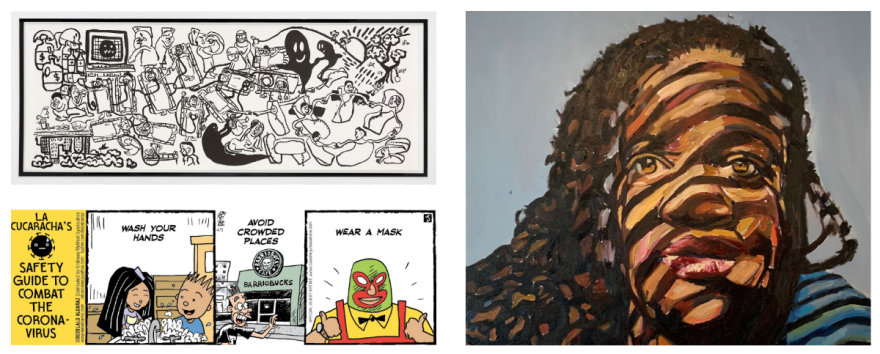In March 2020, the art world — along with most everything else — started shutting down. Doors to museums and galleries closed. Shows and exhibits were postponed. Then postponed again. Then canceled.
But that didn’t mean artists themselves stopped creating. A new exhibition at Charlotte’s Mint Museum shows just how artists were able to adapt to isolation and find inspiration during a whirlwind year of pandemic, uprising, racial reckoning and political furor.
“Silent Streets: Art in the Time of Pandemic” opens April 17 at Mint Museum Uptown. Regional, national and international artists are featured, and mediums include painting, comic strips, collages, photography and video.
“Artists are often the first to respond and react to societal forces and create work that manages to encapsulate abstract concepts of emotion,” Mint President and CEO Todd Herman said of the exhibit in a statement.
While the exhibit features work from many contributors, the Mint’s chief curator, Jen Sudul Edwards, commissioned three North Carolina artists — Charlotte’s Amy Bagwell, Durham’s Stacy Lynn Waddell and Greensboro’s Antoine Williams — to create works in isolation that reflect 2020.
Bagwell, a poet, mixed-media artist and teacher at Central Piedmont Community College, is also well-known in Charlotte for her work on murals in the city and as a co-founder of Goodyear Arts.
Bagwell says the three large collages she created for “Silent Streets” were inspired in part by noticing there was “so much dissonance” in 2020 as the coronavirus and racial injustice dominated conversations at work, at school, at dinner tables, on the street -- everywhere.
“It became maddening,” Bagwell said. “And that is what I have been trying to process in my poems, which is where all of the visual work starts, and then the visual work is an expression of that.”

She started with sonnets that included the questions, “Can you imagine knowing what to do and then doing it?”
Those words are screen-printed more than 200 times across her three installations, along with images from vintage magazines that she said enforced white entitlement. That’s something, she said, that spoke to her after “watching so much denial by white people of truths over the past year,” especially as Americans took to the streets to protest against systemic racism and police brutality.
“These images are meant to be commentary on how we white people have misunderstood so much and have made so many poor collective decisions,” Bagwell said.
Those questions — Can you imagine knowing what to do and then doing it? — apply to last year’s protests and even now, to watching the ongoing murder trial of Derek Chauvin, the former police officer charged with killing George Floyd in Minneapolis.
“It’s all here, it’s all so present, and it never ends,” Bagwell said.
And Bagwell says her work is meant to help frame — rather than provide answers or fixes to — current events.
“I don’t think that art is ever supposed to provide answers,” Bagwell said. “If you’re providing answers in your art, then you’re probably making propaganda.”
As far as framing goes, here’s something to keep in mind about the work in “Silent Streets” and recent art in general: Many artists aren’t necessarily looking back on a landmark moment in history. They —and we — are still in it.
“I don’t think we’ve yet seen the full response to this because we’re still living through it,” said Antoine Williams, the Greensboro artist who created work for the exhibit. “I think with this show what’s interesting is that I’m responding to what’s happening in the moment. But then, also, I think there’s after this moment — how we then look back.”
Williams, who teaches art at Guilford College and helped found the God City Art Collective in Charlotte, has six pieces in his series “What Happens When A Tool Talks Back” featured in the exhibit. The pieces use acrylic skin and rust and incorporate nails in a nod to traditional Congolese power figures.

“In the Congolese power figures, each nail represents a promise broken or a slight,” Williams said. “And I was thinking about that in terms of the climate, the racial climate in terms of what was going on especially in the uprisings, so I began using these nails as well.”
The series title, “What Happens When A Tool Talks Back,” is inspired by something Williams read in “Afropessimism,” a book by Frank B. Wilderson III that he was reading as the pandemic began. It references how Black bodies and Black life are often treated in American society, Williams said.
Williams’ work typically deals with power and perception through the lens of race and critical race theory. So, while the uprisings against racial injustice of 2020 added to the mix, he’d been thinking about the concept for the series for several years. “Silent Streets” provided a perfect opportunity.
“Each piece sort of represents Black bodies and Black imagination and Black thought and this need for Black liberation and just sort of this fatigue of us constantly having to do this work and constantly just for the bare minimum,” Williams said.
Waddell, the third commissioned artist, used textiles to make flags that explore representation and inclusion in symbols of power, according to the Mint. Another prominent feature will be a short film by Charlotte artists Matthew Steele and Ben Gellar called “As the Boundary Pulls Us Apart,” which involved them working from separate spaces to create a spirit of unity even though they were apart. Also included will be syndicated comics that reflect the time of COVID-19 and a series of images from photographers who documented themselves and landscapes during the pandemic.
And, back to the idea of the art right now not necessarily being a look backward: That doesn’t mean that in the future, what’s being created right now won’t help tell the story.
Here’s how Williams puts it:
“The cool thing about art is that it becomes this moment in time, right?”



